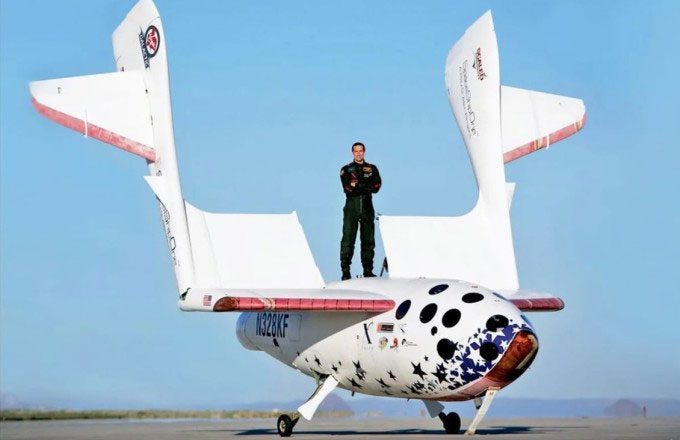Ten years ago, a pioneering test flight into space lasted 24 minutes and entered history as a significant milestone, laying the groundwork for the space tourism industry.
On June 21, 2004, at Mojave Airport in California, USA, after departing from the White Knight carrier aircraft, the rocket engine of the suborbital test vehicle SpaceShipOne was ignited under the control of test pilot Mike Melvill, according to Burt Rutan, chief designer of the aircraft at Scaled Composites.

Pilot Brian Binnie stands above SpaceShipOne in 2004. (Photo: X Prize)
SpaceShipOne was unveiled in April 2003. Before the first space flight, Rutan recalled an aerodynamics expert’s concerns about SpaceShipOne and its new “feather” reentry system employing its unique hinge joints. This innovative design allowed the rear half of the wings and the twin vertical stabilizers to pivot upward during reentry into the atmosphere. This position increased drag while maintaining the vehicle’s stability during descent. The expert suggested that the new system would be very difficult to control. “I do not have wind tunnel data on the feather configuration. I also have very little computational fluid dynamics data. I cannot say whether he is right or wrong,” Rutan quoted. However, SpaceShipOne’s first flight went smoothly.
As SpaceShipOne detached from the White Knight carrier aircraft at an altitude of 12,000 meters, pilot Mike Melvill did not say a word, according to Rutan. SpaceShipOne accelerated from subsonic to supersonic speeds, firing its rocket engine for 15 seconds and soaring above 100 kilometers over Earth, surpassing the Kármán line, which defines the boundary between Earth’s atmosphere and outer space. When the rocket engine shut down, SpaceShipOne transitioned to a slow speed and deployed its feather wing system. The vehicle successfully landed on the airport runway.
Later that year, SpaceShipOne completed two additional suborbital flights above 100 kilometers, piloted by Melvill and Brian Binnie, respectively, to win the $10 million Ansari X Prize. This marked the first time a private aircraft flew to the edge of space, and Melvill’s test flights attracted significant media and public attention. Following SpaceShipOne’s successful first space flight, Rutan promised that suborbital flights would “inspire and open up a new industry.”
This prediction has come true. Both Virgin Galactic and Jeff Bezos are now conducting space tourism services. To date, Virgin has completed a total of 7 suborbital flights with the recently retired VSS Unity spaceplane. Unity is a SpaceShipTwo vehicle, an improved version based on the pioneering SpaceShipOne model. The original SpaceShipOne will be displayed at the National Air and Space Museum.





















































